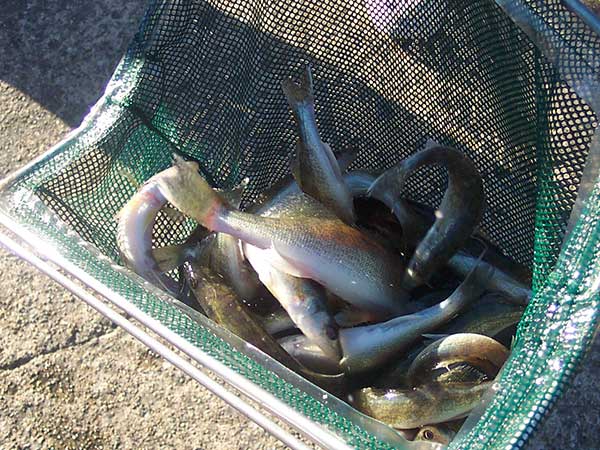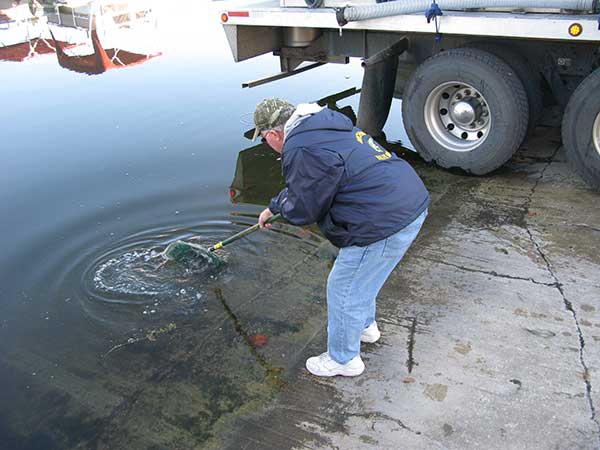By Louie Stout
 Fingerlings in netWhen Barry Ukele and a handful of others started the Michiana Walleye Association in 1993, they shared a dream of consistently catching keeper walleyes from the St. Joseph River.
Fingerlings in netWhen Barry Ukele and a handful of others started the Michiana Walleye Association in 1993, they shared a dream of consistently catching keeper walleyes from the St. Joseph River.
They launched a stocking program with help from the DNR, and while the river has produced decent walleye fishing, keeper-size fish have been scarce.
Until this year.
“We’ve always been able to catch 6 or 8 sub-legal and maybe one legal fish (15-plus inches),” noted Ukele. “But this season has been different. One week this summer, I was catching 8 to 10 keepers and 6 non-keepers. It’s been fantastic all year.”
The difference? River biologist Neil Ledet credits the cooperative efforts with the club to stock larger fish in fewer numbers. The survival is much better as the bigger walleyes survive the winter better and grow faster.
That strategy continued this week when the club and the DNR deposited more than 13,000 chunky, young walleyes into the river. They were released at Maggie’s Landing above the Twin Branch dam and at Midway Bait and Tackle at County Line Road.
The fish were super healthy and measured 6 to 8 inches with a few 10-inchers mixed in. They were purchased from Gollon Bait and Fish Farm, Dodgeville, Wisc. for about $2 each. The DNR money (11,000 fish) came from funds it receives from AEP for river fishery projects while the MWA accrued its money for another 2,000 fish through club projects and fund-raisers.
 Barry Ukele, Stocking ChairpersonIn the early years, the DNR and club stocked 3-inch fingerlings in high numbers but survival was inconsistent. Many of the keeper fish caught this summer were the result of a 2011 stocking in which bigger fish were used.
Barry Ukele, Stocking ChairpersonIn the early years, the DNR and club stocked 3-inch fingerlings in high numbers but survival was inconsistent. Many of the keeper fish caught this summer were the result of a 2011 stocking in which bigger fish were used.
“I’m convinced that’s why you’re seeing more keeper-size fish this year,” said Ledet. “The bigger fish are really paying off. Every time we sample in the spring, we’re seeing good survival of those bigger fish stocked in the fall.”
The stocking is conducted in every odd number year.
So, why not do it every year?
Ledet says the alternate years stocking formula has exhibited proven success for other states. Also, the Elkhart-to-Twin Branch pool of the river has a lot of other gamefish, so he worries about putting too many young mouths in the river and creating too much pressure on the smaller forage. He doesn’t believe skipping a year will impact the fishery given the strong survival of the larger walleyes, but will survey the river periodically to see how the fish are doing.
In the meantime, Ukele hopes walleye anglers will be selective in the walleyes they keep. His club members practice catch and release of all walleyes they catch; while he acknowledges the public’s right to keep legal fish, he’s concerned with the number of smaller fish going onto stringers.
“It’s a bit confusing to some people because Indiana has a 14-inch size limit on other waters, but it’s 15 on the St. Joe,” he offered. “We hope that anglers will use some discretion in the fish they keep. This is still a fragile fishery, but the future looks really bright.”
The walleye club already has fired up its fund-raising efforts for a 2015 stocking. They welcome individual and business donations and will have collection jars at various businesses around the area.





